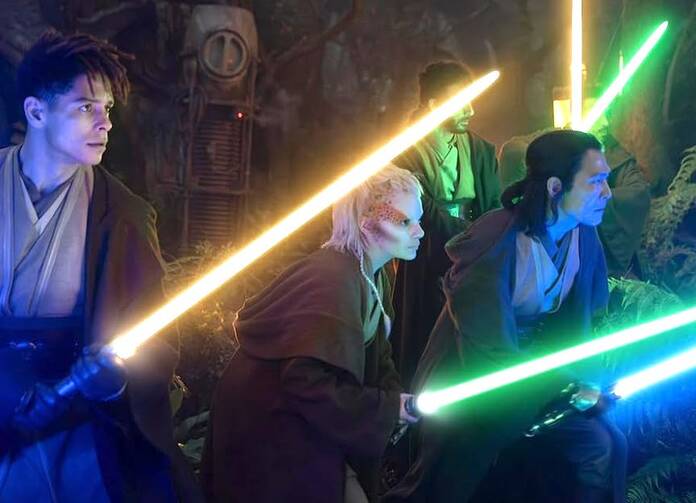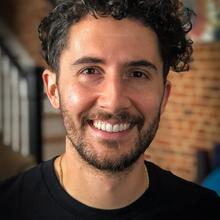This essay contains spoilers for “The Acolyte.”
“I want to learn the ways of the Force and become a Jedi like my father.”
That’s the wish of a young Luke Skywalker, the boy we first met in 1977 in the original “Star Wars” film, designated years later “A New Hope.” He utters these words to old Ben Kenobi, having just stumbled upon a devastating truth: His aunt and uncle have been slaughtered by the Empire. His life on the sandy planet Tatooine now stands at a crossroads. Luke must choose how he will respond.
So, he joins up with the old space wizard and embarks on an adventure. Over the course of the original trilogy, he takes up the mantle of the long-forgotten Jedi Order, wielding his lightsaber as a symbol of hope in an era of darkness and tyranny. For Luke, learning the ways of the Force and becoming a Jedi are one and the same thing.
“The Acolyte,” the latest installment in the “Star Wars” franchise and available now on Disney Plus, knows nothing of Skywalkers or Death Stars. The series—which just completed its first season—takes place in the High Republic era, exactly 100 years before the events of the first “Star Wars” film chronologically, “The Phantom Menace.” It is a period of supposed peace and prosperity in the galaxy, a time when the Jedi are at the height of their power and influence.
And there are many, many Jedi.
Luke Skywalker became a lone Jedi knight scouring the galaxy for insight into the mysteries of the Force. For decades, this was how we understood the Jedi to operate: underdogs, the last bastion of light against an overwhelming darkness. This kind of Jedi had no army to call upon, no political clout to exert. But trusting in the Force, seeking to understand its mysteries so as to serve the galactic greater good, still often proved sufficient to win the day.
We see very little of that humility in “The Acolyte” and its expansive cast of Jedi knights, masters and apprentices. Instead, we see a Jedi Order that has become far more concerned with its standing in the Galactic Republic than with its mission to serve as guardians of peace and justice in the galaxy. We see an institution that is rotting from within.
Over the course of eight episodes, “The Acolyte”unravels a heartbreaking-yet-simple plot: A Jedi field team tasked with conducting research on the planet Brendok has murdered a local coven of Force-wielding witches. Sixteen years later, the members of that field team are being systematically killed. And the Jedi, led by Master Vernestra Rwoh (Rebecca Henderson), seek to neutralize the killer before word leaks to the Senate.
“A scandal like this would inspire fear and mistrust,” Vernestra says. And so, she looks to solve the mystery without alerting even the Jedi High Council. She acts to protect not the galactic common good but the reputation of the Jedi—and with it, their hold on power.
The Jedi field team on Brendok believed they were doing good. Masters Sol (Lee Jung-jae), Indara (Carrie-Ann Moss) and Kelnacca (Joonas Suotamo), along with Padawan Torbin (Dean-Charles Chapman), believed the witches to be a threat to two young girls in the coven’s care. They moved to rescue the twin girls, Mae and Osha (Amandla Stenberg), and acted against what they considered a Force cult. Tensions escalated. Events got out of hand. The entire coven winds up dead at the hands of the Jedi. And because such a dark truth would be devastating to the Jedi’s reputation, it’s concealed.
The Jedi confess to nothing and instead blame the disaster on one of the twins, Mae, whom they believe perished in the disaster. But Mae survived and finds her way to a dark side Force user who sends her on a crusade of vengeance against the Jedi.
It takes a parade of dead Jedi—including most of the original field team—before Master Sol is finally forced to choke out the truth. By then, his past good intentions mean nothing to his former pupil, the stricken Osha. She is the one who completes Mae’s deadly mission; she uses the Force to suffocate Sol.
Sol is an avatar for a Jedi Order that has become too comfortable with its power and privileged place in galactic politics. He is a good man, we learn, who is blind to his own biases. He refuses to entertain the idea that the witches of Brendok may not be, in fact, evil and may actually care for and nurture the children in their charge. He and his fellow Jedi cannot fathom a group of Force users operating outside the boundaries of the Jedi and their teachings; such a group must be up to nefarious ends.
As “The Acolyte” unfolds, we see the deadly fruits of structural violence, a collection of assumptions that privilege one way to the Force over any other. The Jedi Order—bolstered by the support it enjoys in the senate—insists on its teachings as the only path to the Force. Anything else is a form of heresy, and colluding heretics should be dealt with harshly. That Jedi insistence justifies Sol’s infiltration of the witches’ sanctuary, the upending of this local culture’s way of life—their rituals, their customs, their families—and the destruction of its people. That insistence justifies silence and lies. And most tragically of all, that insistence means that Sol is never able to process his own mistakes, to take responsibility, to heal and move on.
In the end, Sol—unable to understand how the prevailing Jedi philosophy has condemned him to internal struggle—becomes a victim of the same violent system that destroyed the witches’ coven. Master Vernestra, unwilling to allow the Jedi to lose their grasp on power, insists on coverups over truth. Even Sol’s legacy becomes a lie.
In the season finale, we witness a confrontation between Master Vernestra and Senator Rayencourt (David Harewood), who has pushed for an external review of the Jedi Order.
“I think the Jedi are a massive system of unchecked power posing as a religion. A delusional cult that claims to control the uncontrollable,” the senator claims. “You project an image of goodness and restraint. But it’s only a matter of time before one of you snaps.”
The senator’s words are prescient. We discover that Qimir (Manny Jacinto), a former student of Vernestra, has been manipulating both Mae and Osha, training them in the dark side. And we glimpse—if just for a moment in the finale—another villain, a Sith Lord still hidden in the shadows, pulling the strings.
This darkness would not have been able to rise, would not have claimed so many lives, if the truth had been known, if forgiveness and justice had been sought. Instead, Qimir preyed on the fear and anger and uncertainty so palpable in so many of the characters.
We don’t need to travel to a galaxy far, far away to see the rotten fruits of institutional lies and coverups, of the fear, anger and uncertainty upon which it feasts.
Ignatius Loyola reminds us that the pursuit of power leads us to the dark side, what he called the Enemy’s Standard. That way leads to isolation, a constant fear over what we might lose and of who might take it from us. Rather, Ignatius tells us to choose a different path, to surrender power and embrace a spirit of poverty, rejection and humility. He reminds us in the Spiritual Exercises that the enemy of our human nature “seeks to remain hidden and does not want to be discovered” and “is greatly displeased if his evil suggestions… are revealed.” Whether in a galaxy far, far away or in one intimate and near, evil prefers to operate in the shadows. We must choose truth and transparency.
“The Acolyte” shows us what happens when even the best of us cozy up to power: We begin to fear its loss. Our decision-making becomes clouded. We seek to protect the wrong things. We act in haste.
Luke Skywalker sought to learn the ways of the Force. He did become a Jedi. But his training was not dictated by the same structures of the past. And he never knew what it meant to have the kind of political power and influence of the Jedi of the High Republic.
Perhaps we would do well to look at our own world, to ferret out those systems of “unchecked power posing as religion.” Perhaps the lesson we take from “The Acolyte” is to not waste time protecting our own grasp on power. Instead, let us use what influence we have to serve and to allow our God to work with and through us as the Spirit deems best, knowing our own needs and contexts. Perhaps we might learn from Sol’s mistakes: to engage others with curiosity rather than fear, and to admit to failure even when the consequences rob us of our power and influence.
After all, the soon-to-be Jedi we met in 1977 had no power to protect. He just had his friends, a belief in a better world and the determination to play his part in realizing it.








